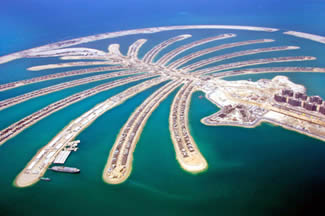Creating new land
Land reclamation is the creation of new land where there was once water. Notable examples include parts of Washington, D.C. (which is partially built on land that was once swamp); Helsinki (of which the major part of the city center is built on reclaimed land); the Cape Town foreshore; the Chicago shoreline, Back Bay, Boston, Massachusetts; the port of Zeebrugge Belgium and the polders of the Netherlands.
Japan, the southern Chinese cities of Hong Kong and Macau and the city-state of Singapore, where land is in short supply, are also famous for their efforts on land reclamation. One of the earliest and famous project was the Praya Reclamation Scheme, which added 50 to 60 acres of land in 1890 during the second phase of construction. It was one of the most ambitious project ever taken during the Colonial Hong Kong era.. Monaco and the British territory of Gibraltar are also expanding due to land reclamation. The city of Rio de Janeiro was largely built on reclaimed land.
Artificial islands are an example of land reclamation. Creating an artificial island is an expensive and risky undertaking. It is often considered in places that are densely populated and flat land is scarce. Kansai International Airport (in Osaka) and Hong Kong International Airport are examples where this process was deemed necessary. The Palm Islands, The World and hotel Burj al-Arab off Dubai in the United Arab Emirates are other examples of artificial islands.
A related practice is the draining of swampy or seasonally submerged wetlands to convert them to farmland. While this does not create new land exactly, it allows productive use of land that would otherwise be restricted to wildlife habitat. It is also an important method of mosquito control.
For habitation or agriculture
Blog Archive
-
▼
2007
(132)
-
▼
October
(28)
- The 1998 FIFA World Cup, the 16th staging of the...
- Creating new land Land reclamation is the creati...
- Hermann Scherchen (June 21, 1891 – June 12, 1966...
- Bosnia and Herzegovina is a country on the Balka...
- Biggar is the name of more than one place. See...
- Crimea (IPA: [kraɪˈmiə]) or the Autonomous Repub...
- Indigenous languages of the Americas (or Amerind...
- Edwin Arthur Jones, an American composer, was ca...
- Edinburgh East and Musselburgh may refer to: E...
- The Narmer Palette, also known as the Great Hier...
- When TV viewers or entertainment professionals...
- The Federated States of Micronesia, is an island...
- Raj Kapoor (Hindi: राज कपूर, , Urdu: راج کپور, R...
- Eisenhower is the fourth studio album and eigh...
- Lamoral, Count of Egmont (November 18, 1522, L...
- The Order of Saint Stanislaus (Polish: Order ś...
- The Environmental Sustainability Index (ESI) is ...
- Amasya is a province of Turkey, situated on the ...
- In some educational systems, undergraduate edu...
- Karol Maciej Korwin-Szymanowski (October 6, 18...
- Yazoo (known as Yaz in the U.S.) was a short-liv...
- Dr. Harold Cardinal (January 27, 1945 – June 3...
- History of nuclear weapons Nuclear warfare Nuc...
- Creighton Williams Abrams Jr. (September 15, 191...
- Themed episodes The roles of other members of th...
- Attrition · Guerilla · Maneuver Siege · Total w...
- In atomic physics, the fine structure describe...
- Ethics & objectivity Sources & attribution News ...
-
▼
October
(28)
 Repairing damaged land
Repairing damaged land